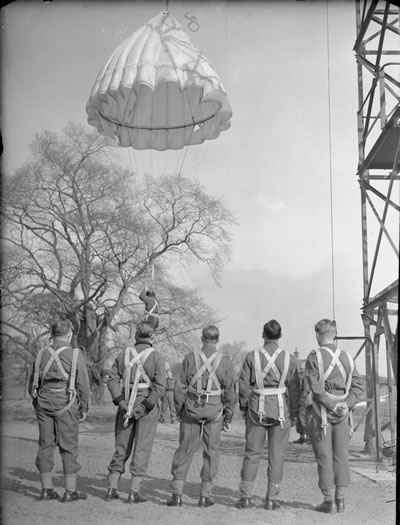The 1st Independent Polish Parachute Brigade
(1 Samodzielna Brygada Spadochronowa)
When Was The
Parachute Tower Built?
According to the date of this photo (23 Sept 1941), the parachute training tower already existed: http://www.iwm.org.uk/collections/item/object/205302626
 © Karta
© Karta
If the tower existed before formal formation of the parachute brigade, It's a fair assumption that the parachute training tower was built initially for the 4th Polish Cadre Rifle Brigade.
This indicates that even before the Brigade changed its name to a "parachute" brigade, there were already plans in place to have parachute trained polish soldiers.
Tower Design
An 8 storey parachute tower (that looked a lot like a crane) was built in 1941 (Completed 25 Augsut 1941) by the Chief Command Staff, besides Lundin Tower in Lundin Links, on the Pilmuir Road side of Lundin Tower. It's arm was 5 meters long.
The tower cost £500 to build and was 100 feet high (Some reports say 75 ft, maybe the head of the arm was 25ft high, meaning the jump was from 75ft but the actual height of the crane was 100ft?). It's purpose was to simulate parachute descent.
Some say the parachute training tower of the 1st Independent Polish Parachute Brigade (1 Samodzielna Brygada Spadochronowa) was built to Polish engineer Iwanowski's specification.
Other statements confirm that the design of the tower was then copied back in Poland.
However, the publication "Operation Market Garden Paratroopers Vol 2 (Piotr Wikkowski) states on page 104 "...was the work of Polish designers of the Engineer Technical Bureau and the Brigade's engineers" this quote came from the source Spadochroniarze, Warsawa 1991 Page 190 (J.Tucholski).
Either way, history supports the fact that subsequent parachute towers in both the UK and the USA followed the specification of the "Largo House" parachute tower.
Controlling Speed Of Descent
According to the experiences of a newspaper columnist who visited the tower and reported on it in The Daily Record Newspaper of March 24 1942, there was an "ingenious mechanism" at the top that offered 5 different descent speeds that ranged from 10 to 25 feet per second.
 © Fife Cultural Trust, Fife Council
© Fife Cultural Trust, Fife Council
An Odd Location For The Tower?
Although Largo House would be the logical place for the tower to be located it is however exposed directly to the North Sea and strong winds.
Likely this is not ideal for training purposes and so the tower is sited between the hills, over in Lundin Links.
Was this site chosen because it was part of Largo Estate at the time? What was the connection between the site of the parachute tower and Largo House? This is unknown at this time, but if I find out I shall report back!
Please Donate!

Uncover The Past - Support The Future
Please don't "grab & go"! Each year, 12,000 people visit this website to trace their Polish ancestry, uncover family stories, and connect with their roots. I believe that history should be accessible to all - but keeping this website alive since 2017 comes at a personal cost to me, 8 years @ £1000 per year (website mgt fees) has left an £8000 dent...with only £380 in total donated up to 27/11/25 😱😱😱.
Every detail you uncover and every story you piece together helps you piece family history together. Please donate if you found the existing information on this site useful, help me keep the site alive! Thanks! Jason Nellyer (Researcher & Site Owner)